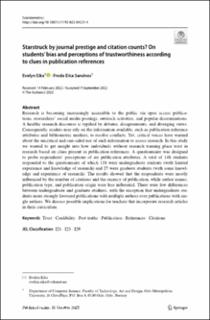| dc.contributor.author | Eika, Evelyn | |
| dc.contributor.author | Sandnes, Frode Eika | |
| dc.date.accessioned | 2022-12-20T13:12:20Z | |
| dc.date.available | 2022-12-20T13:12:20Z | |
| dc.date.created | 2022-10-15T10:02:27Z | |
| dc.date.issued | 2022-10-10 | |
| dc.identifier.issn | 0138-9130 | |
| dc.identifier.issn | 1588-2861 | |
| dc.identifier.uri | https://hdl.handle.net/11250/3038858 | |
| dc.description.abstract | Research is becoming increasingly accessible to the public via open access publications, researchers’ social media postings, outreach activities, and popular disseminations. A healthy research discourse is typifed by debates, disagreements, and diverging views. Consequently, readers may rely on the information available, such as publication reference attributes and bibliometric markers, to resolve conficts. Yet, critical voices have warned about the uncritical and one-sided use of such information to assess research. In this study we wanted to get insight into how individuals without research training place trust in research based on clues present in publication references. A questionnaire was designed to probe respondents’ perceptions of six publication attributes. A total of 148 students responded to the questionnaire of which 118 were undergraduate students (with limited experience and knowledge of research) and 27 were graduate students (with some knowledge and experience of research). The results showed that the respondents were mostly infuenced by the number of citations and the recency of publication, while author names, publication type, and publication origin were less infuential. There were few diferences between undergraduate and graduate students, with the exception that undergraduate students more strongly favoured publications with multiple authors over publications with single authors. We discuss possible implications for teachers that incorporate research articles in their curriculum. | en_US |
| dc.language.iso | eng | en_US |
| dc.publisher | Springer | en_US |
| dc.relation.ispartofseries | Scientometrics;Volume 127, issue 11 | |
| dc.rights | Navngivelse 4.0 Internasjonal | * |
| dc.rights.uri | http://creativecommons.org/licenses/by/4.0/deed.no | * |
| dc.subject | Trust | en_US |
| dc.subject | Credibility | en_US |
| dc.subject | Post truths | en_US |
| dc.subject | Publication | en_US |
| dc.subject | References | en_US |
| dc.subject | Citations | en_US |
| dc.title | Starstruck by journal prestige and citation counts? On students’ bias and perceptions of trustworthiness according to clues in publication references | en_US |
| dc.type | Peer reviewed | en_US |
| dc.type | Journal article | en_US |
| dc.description.version | publishedVersion | en_US |
| dc.rights.holder | © The Author(s) 2022 | en_US |
| cristin.ispublished | true | |
| cristin.fulltext | original | |
| cristin.qualitycode | 1 | |
| dc.identifier.doi | https://doi.org/10.1007/s11192-022-04521-4 | |
| dc.identifier.cristin | 2061609 | |
| dc.source.journal | Scientometrics | en_US |
| dc.source.volume | 127 | en_US |
| dc.source.issue | 11 | en_US |
| dc.source.pagenumber | 6363–6390 | en_US |

